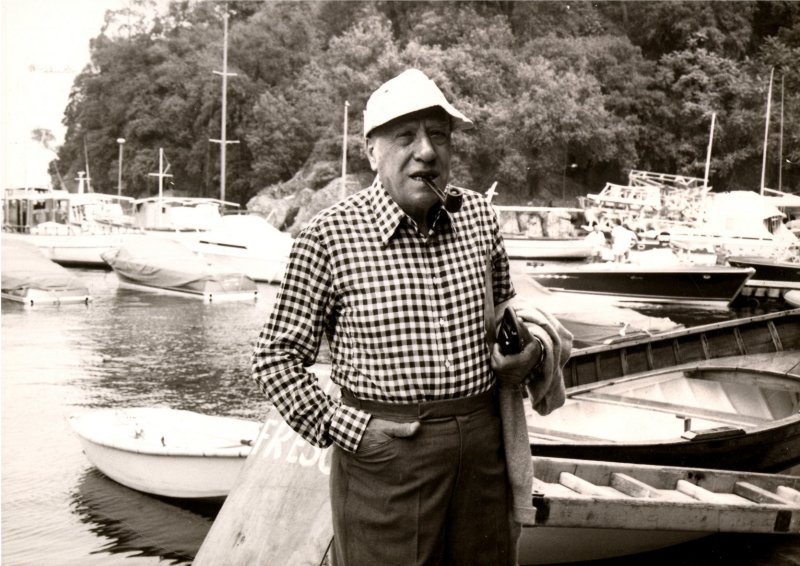Michele Cascella
There are no products to list.
Michele Cascella
Michele Cascella (1892-1989)
Michele Cascella (7 September 1892 – 31 August 1989) was an Italian artist. Primarily known for his oil paintings and watercolours, he also worked in ceramics, lithography, and textiles. He exhibited regularly at the Venice Biennale from 1924 until 1942, and his works are owned by major museums in Italy and Europe, including Victoria and Albert Museum in London, Galerie nationale du Jeu de Paume in Paris, and Galleria Nazionale d'Arte Modernain Rome.

He was born in Ortona a Mare. His father Basilio, who was a painter, engraver, ceramist, lithographer and illustrator, was his first and most influential teacher. Michele Cascella left school early, owing to bad results, and began to work in his father's chromolithographic laboratory in Pescara. Soon Basilio would send Michele and Tommaso alone, at dawn, to the shores of the Pescara River and the surrounding hills or to the Majella to study the scenery from close by and interpret the language of nature. When Basilio felt his sons were ready to show their work, he shifted his role from shop master to organizer and promoter of their art. Michele had now been out of school and working for his father for almost five years. Their first show was held in 1907 in Milan, far from their provincial background. There was talk of enfants prodiges. Michele was only 15 years old.
Michele Cascella sold his first painting privately in 1908 and had his first exhibition in Paris the following year. His technique mainly consisted in the use of pastels. In 1915 at the start of the World War I Italian Campaign Cascella was sent to the front in the Trentino, but he did not stop painting.
In 1919 Michele Cascella moved to Milan where he shared an apartment with his friend and inspiration, the poet Clemente Rebora. He dedicated himself to engraving and ceramics, later returning to oil and watercolor painting.
From 1931 until 1951 Cascella participated in the Rome Quadriennales. In April 1931 he exhibited 28 paintings at the Bastford Gallery in London, where he met the architect Alfred C. Bossom who bought three paintings. He then donated the watercolor The entrance to the village to the Victoria and Albert Museum. That same year he exhibited at the Toison d'Or Gallery in Brussels; in June, the Belgian Minister of The Sciences and Arts stated that it had acquired his painting Evening at Montecatini.
In 1933 the director of Corriere della Sera, Aldo Borelli, invited Cascella to collaborate with a series of sketches of important Italian places. Almost every day, the paper published one of his drawings.
In 1937 Cascella was invited to make the wall decoration for the new Maritime station of Messina. He agreed only to prepare the sketch and left to his father and brother Tommaso the actual execution. He also won the gold medal at the Universal Expositionin Paris.
In 1942 Cascella had a room at the Biennale of Venice, and he exhibited works made at the request of the Ministers of the Navy and of the Air Force.
In October 1959 he made his first trip to the U.S., to New York City. From then on he would spend six months every year in Palo Alto, California, where Isabel Lane became his agent and organized all his shows. Later Cascella was represented by the Juarez Gallery in Los Angeles.
In 1965, while in Ortona, the artist dedicated a painting to Thomas the Apostle, which was donated to the Pontiff Paolo VI.
From 1969 he spent much of his time in the countryside of Colle di Val d'Elsa (province of Siena) with his second wife, Isabel Lane Cascella. He painted many Tuscan landscapes during this period.
The artist died at the age of 97 in Milan and was buried in Ortona. In 2003 he was featured in the collective exhibition "De Chirico et la peinture italienne de l’entre-deux guerres" (De Chirico and Italian Painting of the Interwar Period) at the Museum of Lodève.
Michele Cascella was a very congenial and humane person, as well as a tenacious worker. The techniques he used were pastels, pencil and pen and ink drawings, oils, watercolors, ceramics, lithography and textiles. His most frequent subjects were the landscapes of Abruzzi, locations all over Italy, Portofino, Paris, London, New York, California, Mexico, Hawaii, Tuscany; he also painted flowers, portraits and still life. Cascella himself said that Henri Rousseau and Picasso had the greatest impact on the art world, while Van Gogh, Utrillo and Raoul Dufy most influenced his own work. He is referred to as an Italian Impressionist, post-impressionist and neo-impressionist. Also primitivism and crepuscular landscape art are used to describe his work. Michele Cascella won the gold medal at the Paris Exposition Universelle in 1937. In 1972 and again in 1980 the Comune of Milan gave him a gold medal of merit. In 1975 Michele became an honorary citizen of Portofino. In 1977 the city of Ortona dedicated to him the Pinacoteca Comunale. In 1979, the Academy of Art Dino Scalabrino of Montecatini Terme gave Cascella the Life of artist 1979 prize.


